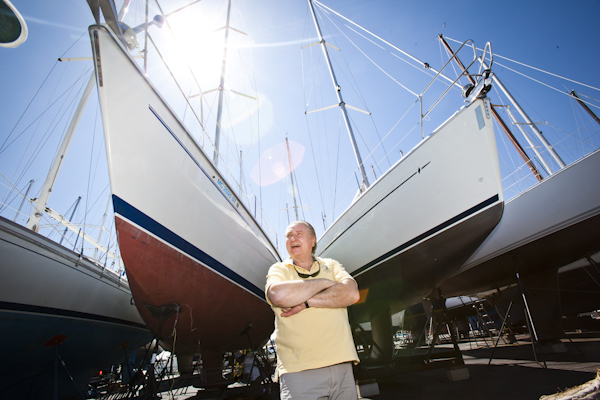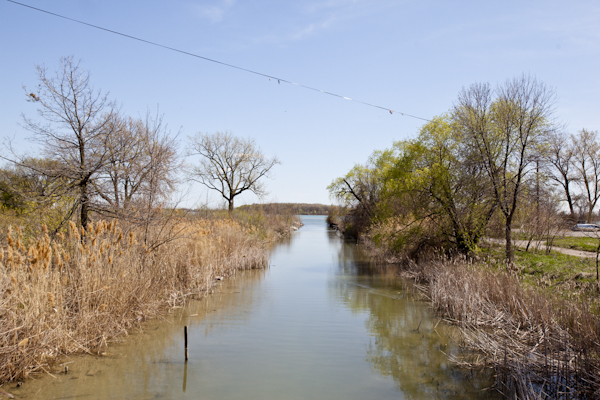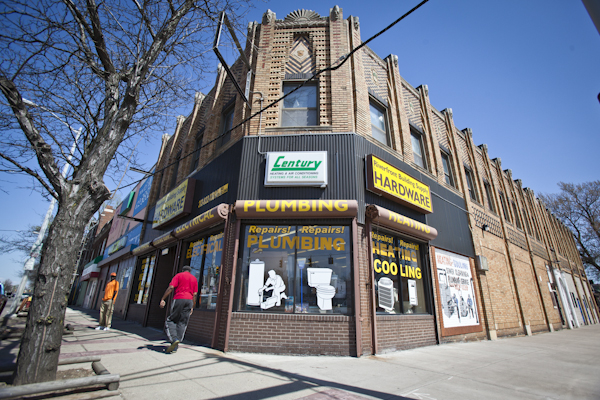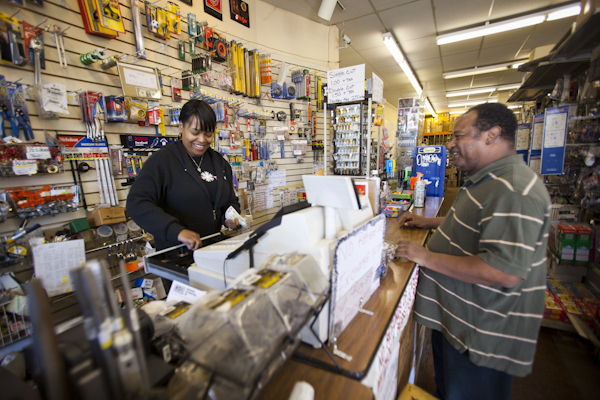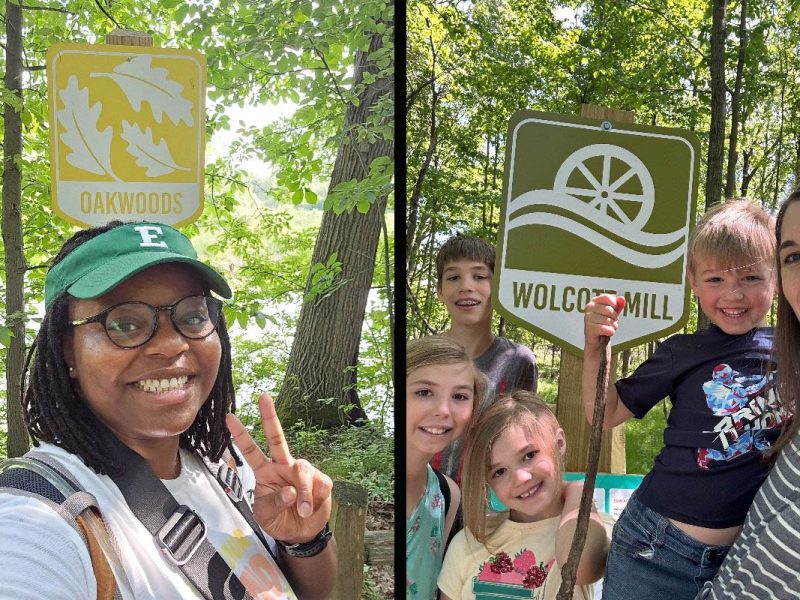On the waterfront: Community life, blue and green economies spur growth in Jefferson East
This far East Side Detroit neighborhood is making strides as a combo commercial-residential area, expanding beyond the business district at Jefferson and Chalmers to include the Conner Creek Greenway, which will extend from the river to 8 Mile when it’s completed. Dennis Archambault reports on the progress.
Hundreds of people pass through Detroit’s Jefferson East gateway at Alter Road on their daily commute. Few notice much north or south of Jefferson, but Jefferson East is a corridor of economic potential.
This riverfront community, boasting more than 160 acres of waterfront parkland, a new greenway, and more boat slips than anywhere in the city, is awakening to the post-recession era and reshaping of Detroit, more expansive in scope than its original seven-block area, but remaining true to its original residential and retail development mission. Its future lies in the “blue” and “green” economies – waterfront and ecology.
The geographic boundaries of Jefferson East have expanded west to McDougall, including industrial businesses and four marinas. It has also expanded in concept as one of the anchors of the newly developed East Jefferson Corridor, comprising the Villages and East Riverfront district.
“It was always our purpose to foster employment opportunities for area residents,” says Joshua Elling, executive director of the Jefferson East Business Association (JEBA) and the East Jefferson Corridor Collaborative. “Our focus had really narrowed to a seven-block area. It’s not that we’ve solved all of the problems in that area, but we’re one of the few organizations with the capacity, the talent, and the board (of directors) to address some of the broader issues. We need to do what they’ve done in the Woodward Corridor.”
In a sense, Jefferson East is two worlds, Elling says: “density and nothing, or urban prairie.” His focus is on strengthening the existing density in the residential and commercial core, dating back to the early 20th century, and then “figure out what’s the future vision north of Jefferson,” which is largely vacant.
Kathy Makino discovered Jefferson East after moving to Grosse Pointe Farms in 2005. Passing through the old business district on her daily commute to her office in the Villages, she wondered why the area hasn’t become more developed. “This should be one of the viable areas (of Detroit),” she says. “The city talks about core communities that have thrived during the downsizing. To me that’s one of them.”
Makino’s company, Shelborne Real Estate, acquired five properties, converting three into Chalmers Square, a $8.5 million investment that will result in 49 residential units and 17,000 square feet of commercial retail space. The project involves the conversion of a former liquor store into a full-service market.
The problem with development in Jefferson East, as with other areas of Detroit, is that “there are a few landlords who’ve owned those buildings for years and years and didn’t do anything with them,” says Makino, who has been developing in Detroit since 1983. She is also a JEBA board member.
Running an independent hardware store in the city is a tough business, says Al Barrow, owner of Riverside Hardware. A lifelong resident of the Jefferson East area, Barrow is doubling the store’s size to allow space for a showroom, “so people can see what they’re buying and buy right off the floor and bring more quality merchandise for reasonable price to stop them from running out of the city to Home Depot.”
The business district has also added a new natural hair salon, Sangaris Salon, and expects to have a new soul food carry-out restaurant by year’s end. Senior housing is also on the horizon for Jefferson East. Earlier this year, construction on Dickerson Manor a $5.7 million 66-unit senior complex which will include a library, hair salon, community center, and other amenities for older adults.
Few areas in Detroit evoke a sense of place as the Creekside and Jefferson-Chalmers neighborhoods. People who once lived there wish they were still there; others want to live there because they know someone who has or does live there. It’s very well-organized in terms of block clubs, school alumni clubs, citizens’ district council, and resident organizations. “The level of social organization in this community is absolutely astounding. if anything it’s almost too organized,” Elling says. It’s also one of the safest areas in Detroit, according to JEBA.
“There are people who very much want the opportunity to move into the city,” says Mark Lewis, whose firm, Community 1st, built its first “green” home in the Jefferson Chalmers neighborhood, which was featured on Discovery’s Planet Green in 2009. Brenda and Albert Jones, looking to move to the city from Southfield, found their dream home in Jefferson East, an area they knew little about. Brenda didn’t want to live in an older house, but she was sold on the new green house. “When I came down to look at it, I fell in love. I thought, wow, I could live here.”
Employees of Greektown Casino, Brenda and Albert can walk to bus stops on Jefferson and their young children can walk Remus Robinson Academy. They’re eight blocks from two shopping centers offering a grocery store and other retail amenities and another small retail strip on Mack at Alter Road. But they’re hard-pressed to find a sit-down restaurant. For that, you go into Grosse Pointe or closer to downtown. For a brew, you there’s the venerable Ye Olde Tap Room on Charlevoix in Detroit. And for health care, Concentra Urgent Care is in the neighborhood, as well as hospital emergency services in the Pointes. Jefferson East is also fortunate to retain its street music festival, Jazzin’ on Jefferson, which this year moves to the July 4th weekend, July 2-3.
The residential neighborhoods are walkable, despite vacant lots and abandoned houses, have good neighbors and are walking distance to the river and acres of parkland, the Jones say. Nearby, the Detroit Eastside Community Collaborate recently dedicated the Conner Creek Greenway at Maheras-Gentry Park, Conner Creek Greenway, and discussions have begun on extending the Detroit Riverwalk to the area.
“This is Detroit’s only single family waterfront community,” he says. “There’s no other place in the city where you can buy a single family house for $100,000 and have access to 164 acres of riverfront parks. You can buy a home on a canal with instance access to the Detroit River.” Weekly during the summer, a flotilla of kayaks paddles through the canals on tours sponsored by Riverside Kayak.
“There have been a lot of requests for paddling in Detroit,” says Tiffany VanDeHey, owner of Riverside Kayak. “The architecture is very nice. We don’t have anything like that downriver. It’s very interesting paddling through the canals.” The tours draw from all over the metro area and usually sell out, she says.
The blue economy is a key driver to the future of the area, says Elling, which was evident to Michael Litts who acquired Keane’s Marina three years ago. A seasoned Detroit business owner, the Grosse Pointe resident calls Detroit “home.” “I love this city. I love what’s going on here. I’ve always been an advocate. You can have a business here and survive. But you have to work at it. No one’s handing you anything.” A former president of Indian Village Association, Litts says he’s invigorated with the possibilities of Jefferson East. A member of the JEBA board, Litts says he’s invested considerably in Keane’s Marina, which also houses five independent boating-related businesses, and is helping to establish a marina district.
Elling envisions the identity of Jefferson East likely morphing into an expansive riverfront community, connecting the Villages with the East Riverfront through greenways and public transit. But the historic center will remain the historic business district and neighborhood development challenge that spawned JEBA. With talks under way to extend the Detroit Riverwalk, Elling hopes the blue and green economies will help create an East Side district that rivals Midtown — which, by the way, wasn’t built in a day.
Dennis Archambault is a regular feature contributor to Model D.

